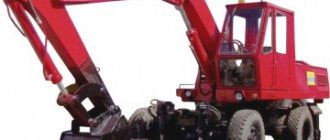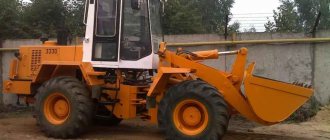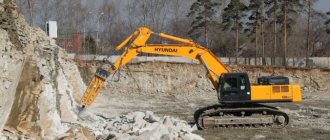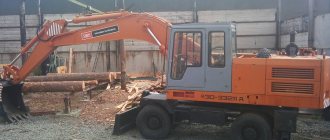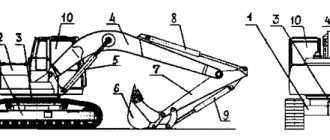Home — Articles — Features of changes in pressure in the hydraulic cylinders of a quarry hydraulic excavator The processes of change in pressure in the hydraulic cylinders of the digging mechanism of an excavator, as a cyclic machine, are mainly of a two-component nature. The overall process consists of a low-frequency continuous component and a periodically occurring high-frequency component. Low-frequency changes in pressure are caused by the periodically repeating nature of the movement of the executive bodies (digging, lifting a loaded bucket, unloading, lowering the bucket into the face) during the excavation cycle. High-frequency oscillations occur during the digging process, when the change in pressure in the hydraulic system is determined by the characteristics of the face, as well as during other operations (starting and braking of digging mechanism elements).
High-frequency components of pressure change processes
High-frequency components of pressure during digging have the greatest amplitude during active penetration of the bucket. The frequency of pressure oscillations is 1…2.3 Hz, the amplitude in bucket hydraulic cylinders is 1.8…4.1 MPa, in handle hydraulic cylinders - 2.3…5.3 MPa. An idea of the process of changing pressures in the hydraulic system during an excavation cycle can be compiled from data from statistical processing of oscillograms obtained during operation of the EG-20 excavator.
Low frequency components of pressure
Low-frequency components of the processes of pressure changes in the piston cavities of the hydraulic cylinders of the boom, arm and bucket are shown with irregular lines, the dotted line shows the envelope of maximum pressures. The broken lines indicate the coordinates of the position of the arm and bucket relative to the extreme positions. Moreover, if the increase in pressure from the zero lines occurs from top to bottom, then the increase in coordinates from the extreme lower positions occurs from bottom to top. Horizontal sections of coordinates indicate the immobility of the element (hydraulic cylinders are locked).
The highest absolute value active and reactive pressures in the hydraulic system during the entire excavation cycle occur during the digging process.
Typically, digging is carried out by simultaneously turning the bucket and extending the handle. The active pressures in the hydraulic cylinders of the bucket and arm increase as the bucket is inserted. The boom gradually lowers under the influence of weight. Maximum pressures develop over time in the second half of digging. Towards the end of digging, the pressure decreases, as the active penetration of the bucket ends and its removal from the face begins. An increase in pressure in the bucket lines occurs as a result of stopping the bucket in the extreme position, when the operator, without feeling this, continues to hold the control handle to turn the bucket.
This style of control is not inherent in all drivers and depends on skills and experience. The last two seconds of digging are taken by removing the bucket from the face by raising the boom to make a turn for unloading.
During the digging process, the pressures developed by the pumps in the cylinders of the handle and bucket are cut off, since the rod and piston cavities are locked, and when the bucket is removed from the face, the excess pressures of the piston cavities are balanced by an increase in pressure in the rod cavities. By adjusting the position of the bucket before unloading, when the bucket, arm and boom are rotated, when the corresponding spools are turned on, excess pressure is released from the piston and rod cavities of the cylinders, and subsequently a reaction pressure is established corresponding to the weight of the soil in the bucket.
What is the hydraulic pressure in an excavator?
Excavator hydraulic equipment
The hydraulic tank is designed to store the working fluid of the hydraulic system. The hydraulic tank is equipped with a filling neck with a filter, a drain nipple, a pressure regulator in the hydraulic tank, a drain filter with a bypass valve. To control the level of working fluid, two oil indicator windows are built into the hydraulic tank. The minimum amount of liquid in the hydraulic tank during operation must be no lower than 0.75 of its volume.
The filters are designed to clean the working fluid of the hydraulic system from mechanical impurities, up to 70.80% of failures during excavator operation occur due to poor quality hydraulic fluid. Two filters built into the hydraulic tank purify the working fluid flowing through the drain line during the operation of the excavator. A bypass valve is installed in the filter cover; If the filter element is dirty, the oil pressure increases. When the pressure increases to 0.25 MPa, the valve begins to open, and when it increases to 0.35 MPa, it releases all the working fluid to drain into the hydraulic tank, bypassing the filter elements.
The hydraulic pump converts mechanical energy into the energy of the flow of working fluid and serves to continuously supply hydraulic fluid under pressure from the hydraulic tank to the hydraulic distributor. The hydraulic system uses gear and axial piston pumps.
The gear pump consists of a housing, a cover, drive and driven gears, bushings, cuffs, liners, and seals. The pump is driven by a diesel engine or gearbox. During operation, oil from the suction cavity is captured by the gear teeth and supplied along the circumference between the gear and the housing into the discharge cavity. The pump can create pressure up to 20 MPa and is used in the hydraulic system of part-rotary excavators or for filling and feeding the system in full-rotary ones. Gear pumps are available as single or double pumps.
In hydraulic full-rotary excavators, adjustable and non-adjustable axial piston pumps are used, creating a pressure of 28.32 MPa.
The axial piston pump (Fig. 5.1) consists of a drive shaft 1 located in a housing 11 on three ball bearings 4, a central spike 6, seven connecting rods 8 connected to the shaft flange 1 by ball joints, seven pistons 9 rolled on connecting rods, block 5 cylinders connected by a key to a central tenon, distribution disk 7 (with inlet and discharge holes), distribution cover 10 and pump cover 2, seals 3 (rings and cuffs).
When shaft 1 rotates, the connecting rods 8 begin to rotate together with the 5 cylinder block, while the pistons in the block will perform a reciprocating movement: half a turn the liquid is sucked in, half a turn it is pumped under pressure through the distribution disk 7. When the axis of the shaft coincides with the axis spike (as shown in Fig. 5.1, a), the pistons do not perform reciprocating motion when the shaft rotates, i.e. do not suck or pump working fluid.
For an unregulated pump, the casing has a constant angle of inclination, i.e. the cylinder block has a constant angle with the shaft axis (Fig. 5.1, b). When the angle of inclination of the cylinder block changes, the performance of the pump changes: the greater the angle of inclination, the greater the fluid supply. If you fix the angle of the cylinder block, the pump becomes unregulated. This design allows the pump to operate in hydraulic motor mode.
An axial piston hydraulic motor is used to drive the travel mechanism and the rotation mechanism in excavators. The designs of pumping units of axial piston pumps and hydraulic motors are unified.
The working fluid from the hydraulic distributor is supplied under pressure through pipelines to the hydraulic motor, passes through the hole in the distribution disk 7 and enters the cylinder of the block 5, moves the piston 9, which turns the flange of the shaft 1 through the connecting rod 8. In the hydraulic motor, the energy of the pressure of the liquid acting on the pistons is converted , into the mechanical energy of the driven link, i.e. rotation of the hydraulic motor shaft that drives the actuator - the travel or rotation gearbox of the platform.
Rice. 5.1. Axial piston pump-hydraulic motor: a - unified pumping section; 6 — unregulated pump-hydraulic motor; 1 - shaft; 2 - cover; 3 - seal; 4 - ball bearings; 5 — cylinder block; 6 — central spike; 7 - distribution disk; 8 — connecting rod; 9 - piston; 10 — distribution cover; 11 - body
Hydraulic cylinders are the simplest hydraulic motors that convert the energy of fluid pressure into the reciprocating motion of the output link, and the output (moving) link can be either a rod or a hydraulic cylinder body. In single-acting hydraulic cylinders, fluid under pressure is supplied to only one cavity; the fluid is returned and displaced under the influence of gravity or a spring. Such hydraulic cylinders are used on outriggers (outriggers) of excavators. In double-acting hydraulic cylinders with a single-sided rod, fluid under pressure is supplied to both the rod and piston chambers. Double-acting hydraulic cylinders with a double-sided rod and combined ones - “tandem cylinder” - are used to extend the telescopic boom. The hydraulic cylinders of the working equipment are hinged at the body and rod using pins on bearings.
On excavators, double-acting hydraulic cylinders with a single-sided rod are used (Fig. 5.2), designed to rotate the boom, handle, bucket of forward and reverse shovels to fill the bucket, move and unload soil, as well as to drive elements of other types of replaceable working parts. Hydraulic cylinders consist of a body (sleeve 3 with an eye 2 welded to it), a rod 7 with an eye, a piston 4 and a cover 8 with screws 12. Hermetic separation of the piston and rod cavities is created by a piston with cuffs 5, 6 and o-rings 9, 13.
Rice. 5.2. Excavator boom hydraulic cylinder: 1 - grease nipple; 2 - eye; 3 - sleeve; 4 - piston; 5.6 - cuffs; 7 — rod; 8 - cover; 9.13 - sealing rings; 10 — wiper; 11 — bearing; 12 - screw; 14 - bushing; 15 — piston mounting
The piston is attached to the inner end of the rod with a nut, fixed with a screw, bushing 14 or other fastener 15. To improve the operating conditions of the rod seals and increase their durability, a wiper 10 and scrapers are installed in the nut. At the ends of the rod and sleeve there are eyes for connecting the hydraulic cylinder with the help of fingers to the excavator and working equipment. Bearings 11 lugs are lubricated through grease nipples 1.
Liquid under pressure is supplied to the piston cavity, moving the piston and displacing liquid from the rod cavity. The hydraulic cylinder rod moves together with the piston; the rod extends, transmits force to the working equipment and moves it. The rod is retracted when fluid is supplied under pressure into the rod cavity.
The excavator hydraulic drive control system is designed to change the direction of movement and regulate the speed of the output links (rod, shaft) of hydraulic motors, as well as to protect the excavator structure from overloads. Regulation of the speed of the output links is achieved by changing the flow rate of fluid entering the hydraulic motor (hydraulic cylinder or hydraulic motor). The main elements of the control system are control devices (valves, hydraulic valves, throttles), mechanical hinge-lever and other systems with the help of which the driver controls the control devices. Devices for regulating pressure operate, as a rule, automatically, and devices that regulate the direction of movement and flow of working fluid are controlled by the driver. Based on the principle of speed (flow) regulation, a distinction is made between throttle and volumetric regulation, and in both cases it can be automatic or manual. Most hydraulically driven full-rotary excavators use non-reversible adjustable pumps (the direction of fluid flow does not change), the volumetric flow of which changes automatically depending on the load. In addition, the number of pumps installed on an excavator is usually less than the number of engines driven from them, so switchgear devices are needed. The hydraulic distributor is also used to change the direction of fluid flow and reverse the movement of the working element.
The hydraulic distributor (Fig. 5.3) serves to direct the flow of working fluid from the pump to the consumer (hydraulic cylinder, hydraulic motor) into one or another cavity (rod or piston), throttling it and draining the working fluid into the hydraulic tank. Hydraulic valves can be monoblock (all spools are located in one common housing) and sectional (each spool in its own housing). Using hydraulic valves, they control the hydraulic cylinders of the working equipment of excavators or the hydraulic motors that drive the movement and rotation of the platform.
Advantages of variable pumps
Throttle control creates a large amount of heat that is not used for its intended purpose. Fuel materials in special vehicles and electricity in industrial equipment are consumed irrationally. Variable displacement hydraulic pumps solve this problem. They provide the ability to change fluid flow with little power consumption. This option is especially relevant when performing long-term work, when you do not have to frequently change the speed of the actuators. The adjustment allows the operator to control the operation and performance of the hydraulic unit.
During dynamic operation of machinery or equipment, it is important to quickly change the fluid flow or maintain its level in conditions of fluctuating pressure. In addition, it is difficult for the operator to independently control the pump when carrying out high-precision work.
An example would be the operation of an excavator or the movement of a loader and bulldozer on a construction site. Hydraulic pump regulators or compensators (as they are called in the West) minimize the role of the human factor. They provide optimal power, pressure and stable flow of working fluid.
Features of pressure changes in the hydraulic cylinders of a mining hydraulic excavator
The processes of changing pressure in the hydraulic cylinders of the digging mechanism of an excavator, as a cyclic machine, are mainly of a two-component nature. The overall process consists of a low-frequency continuous component and a periodically occurring high-frequency component. Low-frequency changes in pressure are caused by the periodically repeating nature of the movement of the executive bodies (digging, lifting a loaded bucket, unloading, lowering the bucket into the face) during the excavation cycle. High-frequency oscillations occur during the digging process, when the change in pressure in the hydraulic system is determined by the characteristics of the face, as well as during other operations (starting and braking of digging mechanism elements).
High-frequency components of pressure change processes
High-frequency components of pressure during digging have the greatest amplitude during active penetration of the bucket. The frequency of pressure oscillations is 1.2.3 Hz, the amplitude in bucket hydraulic cylinders is 1.8. 4.1 MPa, in hydraulic handle cylinders - 2.3. 5.3 MPa. An idea of the process of changing pressures in the hydraulic system during an excavation cycle can be compiled from data from statistical processing of oscillograms obtained during operation of the EG-20 excavator.
Low frequency components of pressure
Low-frequency components of the processes of pressure changes in the piston cavities of the hydraulic cylinders of the boom, arm and bucket are shown with irregular lines, the dotted line shows the envelope of maximum pressures. The broken lines indicate the coordinates of the position of the arm and bucket relative to the extreme positions. Moreover, if the increase in pressure from the zero lines occurs from top to bottom, then the increase in coordinates from the extreme lower positions occurs from bottom to top. Horizontal sections of coordinates indicate the immobility of the element (hydraulic cylinders are locked).
The highest absolute value active and reactive pressures in the hydraulic system during the entire excavation cycle occur during the digging process.
Typically, digging is carried out by simultaneously turning the bucket and extending the handle. The active pressures in the hydraulic cylinders of the bucket and arm increase as the bucket is inserted. The boom gradually lowers under the influence of weight. Maximum pressures develop over time in the second half of digging. Towards the end of digging, the pressure decreases, as the active penetration of the bucket ends and its removal from the face begins. An increase in pressure in the bucket lines occurs as a result of stopping the bucket in the extreme position, when the operator, without feeling this, continues to hold the control handle to turn the bucket.
This style of control is not inherent in all drivers and depends on skills and experience. The last two seconds of digging are taken by removing the bucket from the face by raising the boom to make a turn for unloading.
During the digging process, the pressures developed by the pumps in the cylinders of the handle and bucket are cut off, since the rod and piston cavities are locked, and when the bucket is removed from the face, the excess pressures of the piston cavities are balanced by an increase in pressure in the rod cavities. By adjusting the position of the bucket before unloading, when the bucket, arm and boom are rotated, when the corresponding spools are turned on, excess pressure is released from the piston and rod cavities of the cylinders, and subsequently a reaction pressure is established corresponding to the weight of the soil in the bucket.
Methods for regulating hydraulic pumps
The hydraulic pump must be equipped with a regulator. It consists of the following elements:
- A stepped piston and a pin fixed on it;
- Spool valve with thrust bearing;
- Lids.
We will consider two methods of adjusting the unit: by changing the working volume and using a hydraulic throttle.
The first method is based on changing the position of the spool relative to the pin. This element moves to the left or right, which leads to a change in pressure in the piston with a large diameter. Adjustment occurs by connecting the holes in the screw and the spool distribution belt to drainage or high pressure.
Throttle control is performed by changing the effective cross-section using a throttle connected to the hydraulic motor in series or parallel order. This method is less simple, but requires high energy costs and does not allow achieving high efficiency. Therefore, throttle technology is mainly used in low power conditions or when the drive is idle for a long time.
Hotline (repair, components): +7 (495) 660-04-23
REPAIR AND MAINTENANCE OF ANY HYDRAULICS
Source
Unloading
Unloading is carried out by turning the “jaw” while simultaneously lifting the boom. After unloading, turning the excavator towards the face, the driver lowers the bucket to the starting position for digging. In this case, pressure from the pumps is supplied to the rod cavities of the hydraulic cylinders of the bucket and arm. The boom lowers without pumping. The pressure in the piston cavities of the drives decreases when each of the three elements of the digging mechanism is lowered.
According to the processing of oscillograms of the digging processes of the EG-12A and EG-20 excavators, during the development of rock faces of the Sh - 1U category according to ENV, graphs of changes in the average and maximum pressures in the lines of the piston cavities of the hydraulic cylinders of the handle and bucket were constructed.
Pressure losses in power lines
In the pipeline, the pump - spool block - cylinder cross-sectional areas have different values, so we represent the speed of the working fluid in the form of flow rate. Pressure losses were determined by the difference in pressure at the inlet and outlet of the spool block and in the cylinder cavity.
In the spool block, the pressure drop in the lines of the handle, bucket and boom is 1.8 MPa when operating from two pumps. At operating digging speeds, the pressure loss in the spool block reaches 0.4 MPa.
For the lines of the piston cavities of the boom, arm and bucket cylinders, the losses have similar values and do not exceed 1.5 MPa at maximum cylinder rod speeds. The pressure loss in the pipelines of the rod cavities of the bucket cylinders is 1.8 times greater than in the handle cylinders. During the digging process, the total losses in the lines of the bucket cylinders are 0.3 - -0.6 MPa, in the handle cylinders - 0.35 - 0.5 MPa. When operating at maximum speeds - modes of lifting the bucket for unloading and lowering it into the face, the losses will be 3 and 4.5 MPa for the bucket, 3 and 3.3 MPa for the handle, respectively.
What types of adjustable hydraulic pumps are there?
Hydraulic units with variable displacement are in demand in conditions where it is necessary to quickly and without wasting energy resources change the supply of equipment directly during operation. Today, the following types of pumps are equipped with regulators:
- Axial piston. To perform the operation, it is necessary to change the tilt angle of the washer or block. As the pressure increases, the angle of inclination of the washer decreases; in the opposite order, it increases under the action of the spring. The adjustment function is available in pumps with volumes from 10 cm3 and pressures up to 350 bar. The compensator is mounted directly on the body of the hydraulic unit;
- Radial piston and lamellar (gerotor). The eccentricity between the stator and the stator changes, the supply of working fluid changes in direct proportion.
Excavator hydraulic system and its features
Hydraulics today are installed on any excavator equipment, since it is the key system that ensures its functioning. Each element of it individually and the entire system as a whole serves primarily to select part of the rotational force from the main engine, convert it into the energy of liquid flows and redirect it to the executive bodies and attachments.
The hydraulic control system for excavators consists of a whole set of components and assemblies, including:
- dual adjustable pump with summing power regulator;
- valve block;
- distribution equipment;
- hydraulic motor;
- hydraulic cylinder;
- filter elements;
- collector;
- tank for working fluid;
- hydraulic lines;
- connectors, fittings and fasteners.
A hydraulic excavator can be equipped with two types of systems - dynamic or volumetric. The first option is used extremely rarely due to the complex design, low maintainability and large dimensions of the units. Most often in Ukraine, special equipment is equipped with volumetric hydraulics, in which pressure plays a key role. A volumetric hydraulic drive has more compact dimensions compared to a dynamic system, but the speed of movement of the liquid medium inside it is quite low. To operate, volumetric hydraulics require equipment capable of operating at pressures up to 350 MPa. The working chambers of the hydraulic pump and engine are alternately filled with hydraulic oil and forced out under high pressure.
Methods for adjusting hydraulic pumps
Equipment with a variable volume of the working chamber is equipped with a special mechanism. The regulator consists of:
- stepped piston;
- a finger fixed in it;
- spool with thrust bearing;
- covers.
The ability to adjust pump operating parameters provides significant savings. There are two ways to adjust the hydraulic pump:
- adjustment of working volume;
- throttle regulation.
The first method is based on the movement of the spool, moving to the right or left under the influence of pressure. The second is done by adjusting the effective flow cross section using a hydraulic throttle. In the latter version, the hydraulic throttle can be located perpendicular or parallel to the engine.
Source
Characteristics of hydraulic excavators
- bucket capacity - up to 50.0 m³
- digging depth below the installation level - up to 5 m (straight shovel)
- length of the planned site - up to 14 m
- scooping height - up to 22 m
- scooping radius - up to 22 m
- unloading height - up to 17 m
- unloading radius - up to 20 m
- tail radius - up to 10 m
- bucket penetration force - up to 4000 kN
- breaking force on teeth - up to 1600 kN
- pump drive motor power - up to 2700 kW
- working pressure in the hydraulic system - up to 32 MPa
- number of main pumps - up to 8
- pump flow - up to 8000 l/min
- electric motor power: turning - up to 800 kW, travel - up to 400 kW
- travel speed - up to 0.8 km/h
- ground clearance of the undercarriage - up to 1.05 m
- ground pressure - up to 0.32 MPa
- operating cycle duration: up to 37 s
- operating weight - up to 900 t
Operating principle of an excavator hydraulic system
There is a hydraulic system on any type of excavator. In Ukraine you can purchase special vehicles:
- single-bucket and multi-bucket;
- tower;
- draglines;
- chain;
- rotary – compact and conventional;
- milling;
- trenching.
A set of interchangeable attachments allows you to transform equipment from one type into another and expand its functionality in the shortest possible time. This alone can significantly increase the demand for excavator services and the profit of the machine owner.
The hydraulic system works like this:
- the diesel drive motor rotates the shaft of the pumping hydraulic device, which in turn transforms mechanical energy into hydraulic energy;
- the liquid medium, moving through the pipeline, is directed to the hydraulic motor or cylinders, enters them through the control valves and is converted into mechanical energy or reciprocating motion;
- the working fluid, having completed the work, is drained into the hydraulic lines, returned to the tank, and then supplied to the pump;
- the steps are repeated in the next cycle.
For the normal functioning of the excavator hydraulic system, it is important to meet several conditions. Firstly, entrust the design and installation of units to professionals. Deviations during installation can cause incorrect operation of one or more components, entire hydraulics and the machine as a whole. Premature wear and increased resource consumption and decreased productivity are also possible. The second point is to transport the excavator to the work site with a trawl, and not under its own power. The third condition is to regularly carry out technical inspections strictly according to the schedule developed by the manufacturer, carry out maintenance and timely repairs, use original spare parts and high-quality fuels and lubricants. The fourth point is to involve only experienced specialists - foremen and operators, and follow recommendations and instructions regarding operating conditions and modes.
Types of adjustable pumps
Variable displacement pumps are indispensable where the efficient and economical operation of the hydraulic system requires changing the supply of equipment without interrupting production. The following types of adjustable hydraulic pumps are available on the modern market:
- Axial piston. The volume in them is adjusted by changing the angle of inclination of the block or washer.
- Axial piston. In devices of this type, the pressure from the pump outlet acts on the washer through the piston. When the pressure in the pump increases, the angle of the washer moves downward. When the pressure decreases, the opposite happens - the tilt of the washer increases under the influence of a special spring.
- Lamellar. In such units, the feed changes in direct proportion to the change in eccentricity between the rotor and stator.
- Radial piston. The supply of working fluid in the equipment is regulated according to the same principle as in plate devices.
The required feed is calculated using the formula: Q=q*n, where Q is the feed, q is the volume of the chamber, and n is the rotation speed of the working shaft.
Excavator hydraulic system malfunctions
The design of a hydraulic excavator is complex and extremely reliable, but various types of breakdowns and malfunctions are possible. A serious failure can be diagnosed and corrected only by a competent employee of a specialized service station; the simplest failures can be identified by an operator using his senses. The most common problems that may occur when operating special equipment include the following:
- leakage at the joints of the liquid medium - perhaps the sealing elements are worn out, the threads of the connectors are not tightened properly;
- the pump is too noisy - cavitation, misalignment, wear of couplings and gearboxes are likely;
- foaming of the hydraulic fluid in the oil tank - maybe its level is less than the minimum or air is sucked in at the suction section;
- noise when the valve equipment is turned on - misadjustment, clogging, breakage and wear of the elements may have occurred;
- low speed of operations, insufficient force of working elements - it is likely that there are large leaks of the liquid medium, reduced pump flow, and lost safety valve settings;
- Overheating of hydraulic components - pump, cylinders, motor, distributors, working fluid - can occur due to insufficient oil in the system, clogged filters, breather, malfunctions and wear of units.
Compliance of the operating parameters of the excavator hydraulic system with factory standards is the key to the normal functioning of the machine and its long service life. Therefore, before searching for a breakdown, it is worth checking and measuring the value of the following characteristics:
- fluid pressure on the pump inlet line;
- temperature of working oil and key hydraulic components;
- condition of the working fluid (contamination) and its quantity;
- noise level, presence of knocks.
Installation and installation of a Rexroth hydraulic pump
When installing the pump and motor, it is necessary to ensure the alignment of the pump and drive motor shafts within 0.003 TIR. Split couplings with an elastic element are optimal for Rexroth pumps. Drives such as torsion bars or chain connections are not recommended. The use of belt drives must be agreed with the pump manufacturer Rexroth. To avoid axial and radial loads on the pump shaft, do not install the coupling rigidly on the shaft. A loose, easy fit of the coupling on the pump shaft and the drive motor shaft is allowed. To prevent thrust loading, there should be a 1/2 inch clearance between the ends of the pump shaft and the motor shaft.
Tank and piping
The hydraulic pump must be installed so that the suction pipe has a minimum number of elbows or fittings. The pump suction must be at least 1 inch in diameter pipe. For any system and piping combination, the pump inlet vacuum should not exceed 7 inHg (or 5 inHg for fire resistant fluids). Pipelines must be carried out with reinforced hoses or seamless metal pipes, free of dirt and scale. Do not use galvanized or other pipes that tend to peel.
All drain lines must be located 2" below the minimum oil level in the tank and must be separated from the pump suction area by a baffle. 10 micron return line filters should also be installed here.
The pump drain line must be connected directly to the tank. Drain pressure should not exceed 10 psi; excessive drain line pressure will cause fluid to leak past the pump shaft seal. It is recommended that the pump be drained using separate 3/8" pipes.
Commissioning
The following instructions apply to the initial start-up of a hydraulic pump after installation or repair of a hydraulic pump.
1. Check the RPM marking and model number. The direction of rotation is indicated by an arrow on the casting pump. 2. The pump suction line should fall below the lowest point of the oil level, but not less than two inches above the bottom of the tank. 3. Pump and drive motor shafts should be within 0.003 inches of misalignment. (See above for requirements). 4. Connect the pump drains to the tank (or heat exchanger if the pump will be loaded for long periods of time) using properly sized pipes. When connected to a heat exchanger, a relief valve with a pressure setting of 8 psi must be installed in the drain line parallel to the heat exchanger. The drainage line should not have any other devices or branches and is connected to the tank through a filter. 5. Rotate the pump and motor by hand to check for free rotation. 6. Open the process valve connecting the hydraulic pump output to the tank, or connect the pump output line directly to the tank. Turn the engine on and off several times (two to three seconds each) until the pump fills. Check the direction of rotation of the pump shaft. Attention - the wrong direction of shaft rotation will lead to serious damage and subsequent expensive repairs to the Rexroth hydraulic pump. 7. Once the pump has been primed, run it for a few minutes at low pressure with the drain to the tank open. This will remove air from the hydraulic system. 8. During running work, do not touch the hydraulic pump adjustments. 8. After removing air from the system, close the process valve and you can adjust the pump pressure. 10. If necessary, you can also set the power regulator to the desired value. 9. If it becomes necessary to replace the pumps with a new one or repair the pump, the suction pipe and tank must be removed and thoroughly cleaned. In addition, the suction line from the tank to the pump should be flushed inside and out to remove any contaminants. Pieces of metal from a damaged pump may become trapped in this line. If they are not removed, they will be drawn into the repaired pump and damage it. Start the unit using the appropriate pump start procedures as noted earlier.
JCB Backhoe Loader Hydraulic Manual
The hydraulic system of the backhoe loader ensures the full functioning of the working machine. Thanks to hydraulics, it becomes possible to operate attachments: a bucket, front and rear booms, a hydraulic hammer, a snow blower and other equipment. The hydraulic system consists of a huge number of elements that are closely interconnected and can only function effectively in combination. Failure of any unit can result in downtime.
Design and principle of operation of the hydraulic system
Backhoe loader hydraulics include the following components:
- hydraulic pump;
- valve and hydraulic valve blocks;
- hydraulic lines - metal pipelines and flexible hoses (high pressure hoses) through which working fluid is supplied;
- filter elements;
- hydraulic motor;
- collector;
- hydraulic fluid tank;
- fasteners and connecting elements.
Each detail solves its own problems. The key element of the hydraulic system is the hydraulic pump, which serves to supply oil in the right direction at the right speed by creating the required level of pressure. No less important are hydraulic valve blocks, which are responsible for distributing hydraulic flows that enter the necessary parts of the system through high-pressure hoses. The hydraulic system hoses are connected by couplings that provide a tight seal and prevent leakage of the working fluid. Valves are used to regulate power settings and are responsible for increasing or releasing pressure in the system.
The expansion tank is used to collect and temporarily store excess hydraulic oil, which expands when heated. The hydraulic system of a JCB backhoe loader holds approximately 130 liters of oil. Filter elements ensure the cleaning of the working fluid from debris, dust, foreign particles, wear material and other contaminants.
The principle of operation of the hydraulic system is simple: the working fluid flows from the tank into the pump, which supplies it to the hydraulic distributors through high-pressure hoses using spool valves that set the direction. The oil circulates in the system and returns to the tank, passing through the filter elements.
Do-it-yourself excavator hydraulic pump adjustment
Attention! The forum administration (including moderators) does not sell technical documentation, spare parts or equipment. If a forum user offers you any product on behalf of the forum administration, then he is a fraudster. Don't transfer money to him!
| Page 1 of 4 | 1 | 2 | 3 | 4 | > |
Discussion of diagnostics and adjustment of hydraulic pumps (motors). There are many questions the answers to which cannot be found in those. documentation for equipment. (I searched and didn’t find a similar topic)
I work as a hydraulic test bench operator (diagnostics of hydraulic pumps/motors). I have some practical experience in repairing excavator hydraulics, but my knowledge of special equipment is mostly theoretical. If anyone is interested in the topic, I may be able to answer questions, provide advice, etc.
Let me clarify right away so that there are no unnecessary questions for me (taking into account my previous experience of communication on forums): I do not repair excavators. I do not repair hydraulic pumps.
I’m not sure that this topic is needed at all, let it be an experiment.
And so the first question. Hydraulic pump Komatsu HPV95+95. Does anyone know how much the minimum displacement limiter should be set?
From this series, I had only two pumps (of different designs) on my stand, and on both of them the minimum was initially set very close to zero. One was removed from the excavator for diagnostics and repair, the other was brought by a customer-sold for inspection (with suspicion of defects). The first one is from the PW220-7K excavator, it’s even more or less clear. (on this excavator the control is powered from a separate NC) The second is from the PC290NLC-6K excavator. For this excavator, control is taken from the first section of the main hydraulic pump. The minimum was set from the factory so that with full overlap (and LS turned off) the pump pulled no more than 30 kg/cm2. For the control system, he needs 36-40 kg/cm2 (36 is written in the documentation, 40 can be seen when taking measurements on a similar excavator). At the same time, the client complained that nothing worked on the excavator with this particular pump! (I can’t check the excavator itself - it’s very far away). I have a suspicion that this is due to the small minimum setting. The limiter bolt was unscrewed all the way. Otherwise there was nothing unusual about the pump. And yes, the documentation does not say how much it should be. And it’s not a fact that this setting has a significant effect on anything at all.
Hydraulic valve blocks - the “circulatory system” of special equipment
A backhoe loader is a multifunctional piece of equipment that performs different tasks: lifts and lowers loads, digs the ground, and turns the platform. All mechanisms responsible for the operation of attachments are driven by a hydraulic system. The hydraulic pump sends oil flows in a given direction, setting the speed of movement; distributors ensure the movement of flows in the desired direction.
The hydraulic valve block is a kind of “circulatory system” of a backhoe loader. The hydraulic system of special equipment includes hundreds of hoses - high-pressure hoses, which are located on the bottom of special equipment, on the front and rear booms. Working fluid flows through these hoses, like through arteries and veins. The front and rear distributors determine the power settings of the hydraulic fluid: in which direction, at what time and at what pressure the oil is sent.
How to adjust the hydraulic pump
The ability to regulate the flow of working fluid in hydraulic pumps is most relevant for systems used during long-term technological operations. A striking example is excavators, bulldozers and loaders operating on construction sites. Hydraulic units with variable displacement can cope with this task. An adjustable hydraulic pump is a device that allows you to change the volume of the working chamber and control the flow parameters. Before we figure out how to adjust a hydraulic pump, let's figure out what types of adjustable hydraulic devices exist.
What is a valve system for?
The valve system includes various sensors, solenoids, spools and control valves that are installed on hydraulic valves and are responsible for relieving, raising, decelerating and accelerating pressure in the hydraulic system. Depending on what work needs to be done, the valves increase or decrease the pressure, sending oil through other high-pressure hoses to certain parts of the hydraulic system of the special equipment. Safety valves help to avoid overpressure and backflow of working fluid.
Hydraulic tank accessories
The following elements and devices are installed in hydraulic tanks: breather, filler neck with strainer, working fluid level sensor, working fluid temperature sensor.
Breathers
Breathers are designed to clean the air from mechanical particles and are installed on the upper surface of the hydraulic tanks of self-propelled vehicles. The breathers are equipped with paper or synthetic filter elements. In Fig. Figure 1 shows a typical design of a hydraulic tank breather.
Rice. 1. Typical design of a hydraulic tank breather:
| 1 - body; 2 — filter element; 3 - landing thread |
Filler neck
The filler neck with a coarse mesh filter is used to fill and filter the working fluid. The filler neck is often combined with the breather into a single unit, which simplifies and reduces the cost of the hydraulic tank design. In Fig. Figure 2 shows a typical filler neck design.
Fig.2. Typical filler neck design with strainer and breather:
| 1 - body; 2 — filter element; 3 — removable cover; 4 - mesh filter; 5 — chain of removable cover |
Fluid level sensor
The working fluid level sensor is used to determine the minimum volume of working fluid in the hydraulic tank. Electrical and visual sensors are used. The electrical sensor diagram is shown in Fig. 3.
Rice. 3. Diagram of the electrical working fluid level sensor:
| 1 — float; 2 — float stop with inductive switch; 3 - rod; 4 — flange for attaching to the hydraulic tank; 5 - electrical connector |
The float, which drops along with the liquid level to the lowest point, acts on the inductive electrical switch and sends a signal to the warning light on the machine control panel or to the sound device. Visual sensors are installed on the side surface of the tank. They operate on the principle of communicating vessels (Fig. 4).
Fig.4. Diagram of a visual working fluid level sensor:
Hydraulic system malfunctions and repairs
Like other backhoe loader systems, hydraulics can fail. The reasons are different: wear, sharp impact, excess pressure. Any elements of the system may be damaged, so do not immediately change the hydraulic pump - perhaps the problem lies elsewhere. Diagnostics will help you figure it out. Sometimes, to troubleshoot problems, it is enough to replace oil seals, spool valves and other consumables. In other cases, the cause of the problem is worn out hoses, due to which the working fluid begins to leak.
If you notice that the performance of special equipment is reduced, the oil in the hydraulic system is overheating, and leaks are detected, we recommend that you carry out diagnostics and promptly eliminate the malfunction. Timely repairs will help to avoid more serious breakdowns and prevent forced downtime of special equipment.

